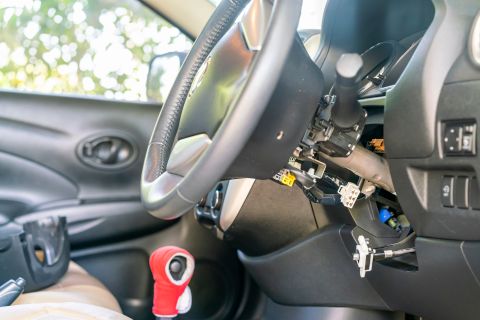Thinking of the ultimate getaway? Australia is cram-packed with hundreds of sites tucked among beautiful scenery. To get there, all you need is a decent 4WD. Some basic gear will provide the creature comforts of home, and a few mates will get the laughs.
Connect with a verified mechanic in minutes. No appointments. No high fees. No waiting. Get back on the road and enjoy the ride.
Speaking of 4WDs, the Mitsubishi Pajero sits squarely between sheer off-roading capability and being downright affordable. It’s been a notable alternative to all the LandCruisers and Patrols out there, and over 150000 Pajeros call Australia home since the first cars were imported in 1983.
With a frugal four-pot diesel, a real 4×4 drivetrain, good ground clearance and rated for towing 3000 kilos, this is the car you’d want in the rough stuff. The boot is huge, and there’s ample space for seven. If you’re going fully loaded, take advantage of the long roofline to fit a bespoke Pajero roof rack. This will prove its worth both when off-roading and camping.
You’ll find the right Pajero roof rack for sale in a dedicated 4×4 accessories store, along with general spare parts like oil and brake pads, vehicle protection and recovery gear you’ll need in the dirt, assorted accessories for inside and out, and a range of camping gear.
Pajero Roof Racks – What You Need to Know
If you’re lucky to have your car with a factory-fitted roof rack, then all you need to do before that big trip is to check in what condition it is. If the rack is below par, with visible dents, cracks or rust, consider an aftermarket Pajero roof rack for sale. These are marketed as either universal roof racks that fit most 4WDs and routes sold in Australia or are vehicle-specific models. Here’s what to look for before buying:
Connect with a verified mechanic in minutes. No appointments. No high fees. No waiting. Get back on the road and enjoy the ride.
Designs
The design of the roof rack determines what can be placed on top. This has got to do with the loads you intend to carry. Roof rack platforms are flat and able to carry a range of items, from camping gear like tables, chairs and solar panels, to sporting goods like kayaks and bikes. The Pajero’s long roof line lets you fit platforms up to 2200mm in length. These have several reinforced internal cross-bars to handle the weight.

Roof baskets or cages are another popular option as they allow you to safely carry a range of gear and not just the big stuff. Items like spare tires, gas bottles, jerry cans, recovery gear, tool boxes, fishing gear and anything that fits. Baskets have raised front, side and rear rails to tie down any gear and supported with the same mesh wire like that found in roof platform racks.
Tradesman racks are a variation of baskets in that the front and rear rails are missing, so tradies can fit extra-long loads like ladders, timber and building materials. Campers can benefit from aftermarket tent-top racks, good for dozing off in wet and damp areas, or as storage area in itself.
Mounting
Roof racks can be mounted to raised side rails stretching the length of the roof line. This is common in bigger off-roaders like the Pajero. Or racks can be bolted onto fixed mounting points inside the roof or the door jamb. Smaller SUVs and cars can have flush mount rails on either side of the roof, but are limited in the type of cargo and racks they can carry. Larger platforms and baskets will also need crossbars that distribute the weight load evenly on the roof. All aftermarket roof racks are supplied with rails and mounting brackets, but some may require you to purchase crossbars separately.
Size, Materials and Weight Loading
Besides getting something compatible and in the right width and length, a Pajero roof rack for sale should be made of quality materials and have high weight loading. Pajero owners are only limited by the length and width of the roof up to the brackets (2200mm by 1250mm) so there’s heaps of space for a lot of goodies. Go for light yet sturdy materials that will last in different road and weather conditions. Generally, off-roading racks are better built and will last longer.
The largest aluminium baskets weigh around 35 kilos, so won’t encroach on the Pajero’s recommended roof loading of 100 kilos as much as heavier stainless steel roof racks. Both aluminium and steel racks are rated for at least double the roof loading, so they’ll hold, just don’t get carried away with chucking everything on top.
Snorkels
Snorkels are necessary when off-road. Their purpose is to provide cleaner air for combustion. This can be impossible when driving through creeks and river beds, or from dust and rocks spraying at the height of the stock air intake.
Set higher up, a snorkel also conducts air in the engine at the desired angle and pressure for optimal performance. There are plastic and cheaper snorkels, or fully-metal variants supplied with everything you need for a tight, sealed fit.

Towing Gear
The Pajero is rated to safely tow up to 3000 kilos, and this covers most caravans, trailers, and smaller boats. Your car needs to be fitted with a rated tow bar, integrated tow ball and wiring for independent braking. Drivers will benefit from brake controllers in heavier towed vehicles, as these significantly up safety, especially at highway speeds.
Also on the safety front, towing mirrors are another inexpensive accessory for any Mitsubishi 4WD, SUV, or ute, as they remove blind spots in turns, let you judge backing up, and help when things get tight.

Review engine, brake issues, error codes and more with a Mechanic Online in just minutes.
Ask a Mechanic Live NowAll Things Camping
The Pajero is great for camping, hunting, fishing and the short trip to the beach. A roof rack can carry a lot of the gear you need, and items that you can’t fit in the boot. Get some basic camping furniture, like folding chairs and tables, a gas or electric stove to muster a tasty meal, a 12V fridge to keep drinks cold and food fresh, plates and cutlery, as well as awnings to get some shade.
If you’re spending the night, good quality swags and tents are a must and some matting to keep feet dry. Inexpensive lanterns, LED lights and a torch come in handy in the dark and can bring some comfort around the campsite.
Other Necessities
What else you decide to get for your Pajero depends on where you plan on going. If you’re heading deep in the bush, then recovery gear in the form of straps, shackles, and jacks is mandatory. To use these check that the Pajero has rated recovery tow points fitted.
In addition, taking spare parts is reasonable for longer trips. Spare tyres and batteries, jumper leads, light bulbs, fuses, oil, and coolant are worth the space (and added weight) they take up since you’ll never know when you need them. And remember to take all the water you can pack.
Whatever you do, source your gear from a well-stocked 4×4 accessories store. All parts sold there have passed rigorous testing and are specced to strict Aussie standards. This includes aftermarket products that can also save you some money and that you can use towards your next trip.
Max Anthony
Max is a gizmo-savvy guy, who has a tendency to get pulled into the nitty gritty details of technology and cars. He attended UT Austin, where he studied Information Science. He’s married and has three kids, one dog and a GMC truck and a Porsche 911. With a large family, he still finds time to share tips and tricks on cars, trucks and more.
Review engine, brake issues, error codes and more with a Mechanic Online in just minutes.
Ask a Mechanic Live Now




